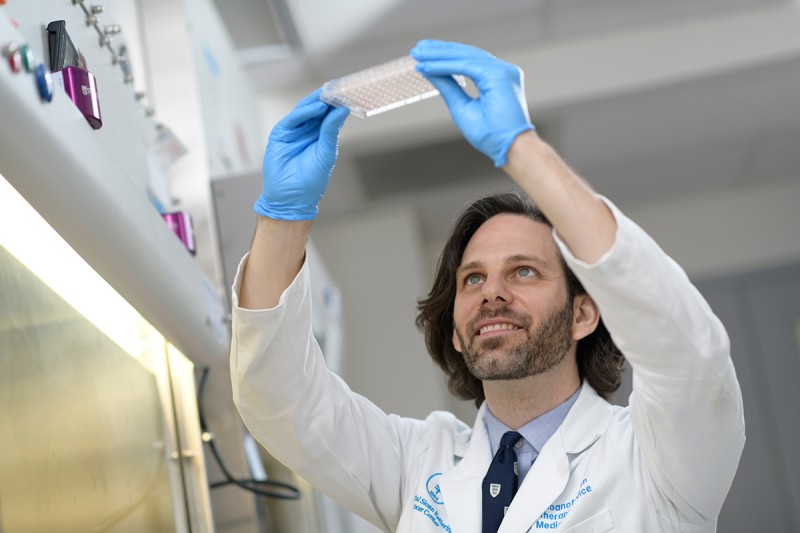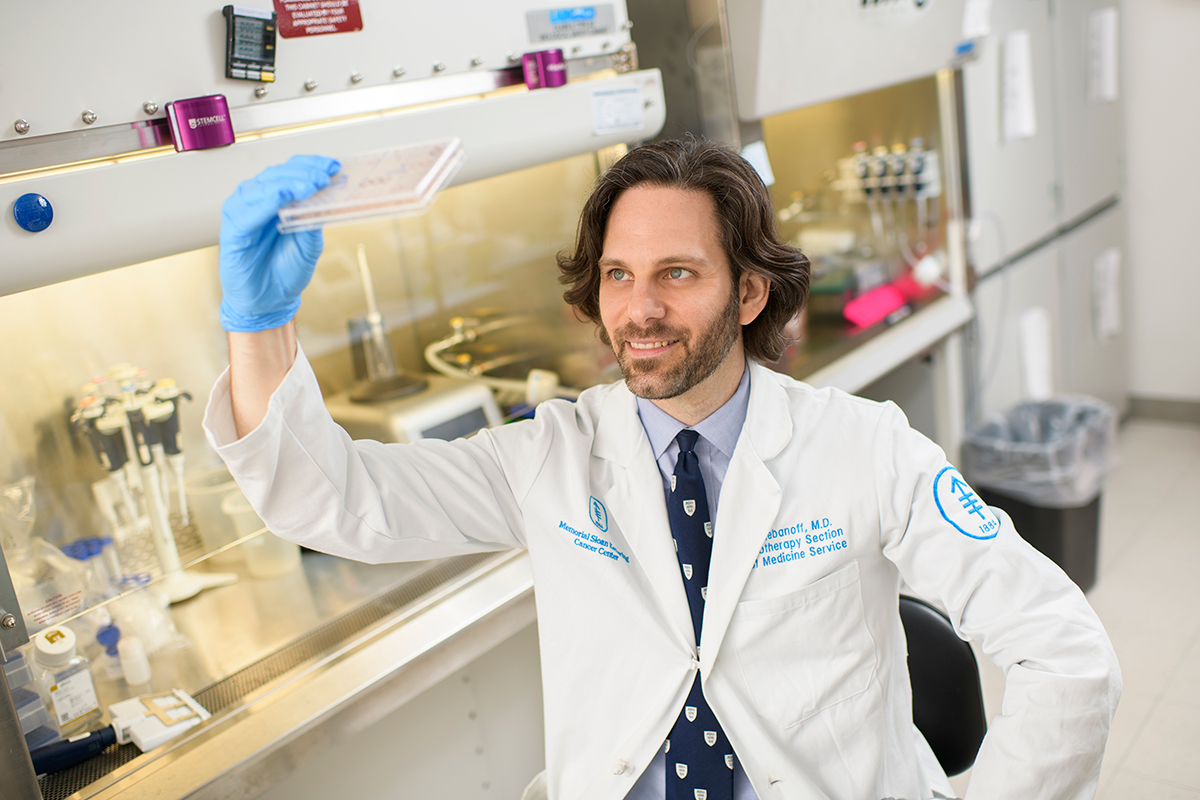
Dr. Christopher Klebanoff is dedicated to bringing the promise of immunotherapy to more people with cancer.
When Christopher Klebanoff, MD, came to Memorial Sloan Kettering Cancer Center (MSK) from the National Cancer Institute in 2016, he was focused on a singular goal: bringing the promise of cellular immunotherapies to the more than 80% of cancers that as yet lack an effective immunotherapy option. That large fraction includes many of the most common and deadly types of solid tumors, including breast, ovarian, colon, and pancreatic cancer.
What makes these cancers so stubbornly unresponsive to existing immunotherapies? Essentially, it comes down to a lack of easily recognizable immunologic targets displayed by cancer cells.
“Our immunotherapies can be very potent, but they are only as smart as their ability to distinguish cancer cells from normal healthy cells,” Dr. Klebanoff says.
In many cases, cancer cells fly under the radar of immunotherapy because their identifying markers are on the inside of the cell and not the outside.
To ferret out those devious cells, Dr. Klebanoff has been developing a type of immunotherapy that can overcome other treatments’ limitations. The approach is called T cell receptor (TCR) therapy, and it involves developing custom-built immune cells that can detect cancer markers that come from the inside of cancer cells.
It’s not quite like having X-ray vision, but it’s close.
Clearing the Hurdles To Make Immunotherapy More Effective
MSK has a history of pioneering immunotherapies for cancer. The cell-based immunotherapy called CAR T, for example, got its start here. It works very well for people with hard-to-treat blood cancers, including leukemia, lymphoma, and multiple myeloma, that have easily detectable markers on the outside of the cancer cells. Immunotherapy drugs called immune checkpoint inhibitors also came out of MSK research. They work well for people with tumors whose abundant genetic alterations make them especially conspicuous to the immune system — cancers like melanoma, non-small cell lung cancer, and certain forms of hereditary colon cancer. But most other solid tumors are insensitive to both these immunotherapies, so better options are needed.
Dr. Klebanoff has spent more than 20 years thinking about this problem. He’s identified three main barriers that must be overcome to bring the promise of immunotherapy to the greatest number of patients.
1. Finding targets that are truly cancer-specific
It doesn’t do any good if your powerful lab-engineered T cells attack cancer cells and normal cells with equal vigor. That would cause significant side effects. What is needed instead are T cells that seek out cancer cells like a bloodhound while ignoring nearby healthy cells.
2. Finding targets that all cells in a tumor share
In a typical tumor, not all cells are the same. They may have many unique mutations and display different markers. If a treatment is specific for only one of those markers, only some of the tumor cells will be eliminated, leaving the rest to grow and spread. This is a central problem with many existing cancer drugs.
3. Finding targets that tumors can’t shed
Tumors are a genetic hodgepodge. Some mutations in a tumor are drivers of the disease, while others are passengers — just along for the ride. It’s not effective to target passenger mutations because a tumor can easily shed these without surrendering any of its cancerous power.
Having studied these hurdles for years, Dr. Klebanoff believes that the best way to clear all three is to focus immunotherapies on cancers’ driver mutations.
“These driver mutations operate like a car that has its accelerator stuck on,” Dr. Klebanoff says. “They just keep revving and growing and charging forward.”
Such driver mutations are ideal targets because it’s very difficult for cancers to shed these mutations and still be cancerous.
What’s more, the driver mutations that tend to cause cancers are mostly the same in different people: Just a handful of genes tend to be mutated over and over in multiple kinds of cancer.
“If you have an immune cell therapy that can recognize this class of markers — what we call public neoantigens — it would lend itself to more of an off-the-shelf approach as opposed to a bespoke or boutique one,” Dr. Klebanoff says. “It would allow us to treat groups of patients using the exact same therapy. This means we can efficiently scale the treatment, offering it to more people than would otherwise be possible.”
Common Cancer Driver KRAS-G12D Is Public Neoantigen No. 1
You might wonder, “If these mutated genes are such an attractive target, why don’t we already have immunotherapies or other drugs to target them?” The answer is that they aren’t accessible to most immunotherapies because of where they are — inside the cancer cells.
And that is where T cell receptor therapy has a huge advantage over other types of treatments. T cells have evolved over millions of years to detect precisely this kind of intracellular actor.

“Having been working on this for 20 years, I believe in the potential of this type of immunotherapy,” Dr. Klebanoff says.
The secret to their success is that most cells in the body are constantly recycling their components, including mutated driver proteins. As part of this housekeeping, they chew up proteins into tiny pieces and send these small fragments to the surface of the cell where they sit inside what Dr. Klebanoff calls a “molecular basket.”
These tiny fragments go unnoticed by antibodies and other immune actors, but for T cells, these bits of protein sitting in their molecular baskets become like the red flag of a bullfighter, spurring T cells to charge and attack. A T cell with a receptor that specifically matches that bit of protein will latch on to it, triggering the T cell to kill that cell.
Dr. Klebanoff’s lab has developed off-the-shelf T cell receptors specific for several public neoantigens. The first one they plan to test targets a mutation called KRAS-G12D, which is the most common mutation in the most common driver gene in all of human solid cancers. Think of it as public neoantigen No. 1.
Building a Better Immune Therapy
To build his engineered T cells, Dr. Klebanoff has relied on MSK’s unique capabilities as a cancer hospital that boasts one of the foremost research enterprises in the world. MSK offers three key advantages for this research, he says.
- The first is the fact that essentially every patient treated at MSK has their tumor sequenced with MSK-IMPACT®. This test reveals whether a patient has the appropriate driver mutation and the appropriate molecular basket for the T cell therapy.
- The second is the close connection between the lab and the clinic at MSK. This relationship has allowed Dr. Klebanoff to study the blood of patients in his lab to identify the best T cell receptors for use as a TCR therapy.
- The final advantage is having a facility to engineer a patient’s T cells with the new T cell receptor and then multiply them into billions of copies before giving them back to the patient in the hospital.
“MSK is one of the very few institutions in the world that has the ability to make these kinds of innovative genetic medicines,” Dr. Klebanoff says.
A Library of Therapies To Pull Off the Shelf for Patients
Even with all these promising attributes of the therapy, one very big challenge remains. It turns out that the molecular baskets that hold the fragments of cancer-promoting proteins can be vastly different among people. These baskets are similar to our blood type, but instead of having four options — A, B, AB, and O — there are thousands. Therefore, a T cell that recognizes one basket type will not necessarily recognize another.
This might have meant that each patient would need a personalized T cell receptor therapy made just for them — the epitome of a bespoke approach. Fortunately, there are some varieties of baskets (the technical term is HLA) that are relatively common. Over the past several years, Dr. Klebanoff and members of his lab have been assembling a library of T cell receptors that recognize this set of common HLA baskets. Having such a library means being able to pull a therapy off the shelf to match with a patient.
And that means potentially making the treatment more accessible to more patients.
A clinical trial (research study) of the new therapy is scheduled to open in 2024, although regulators must still give the final green light.
“Having been working on this for 20 years, I believe in the potential of this type of immunotherapy,” Dr. Klebanoff says. “I only hope we can get it to patients as soon as possible. Many can’t wait.”